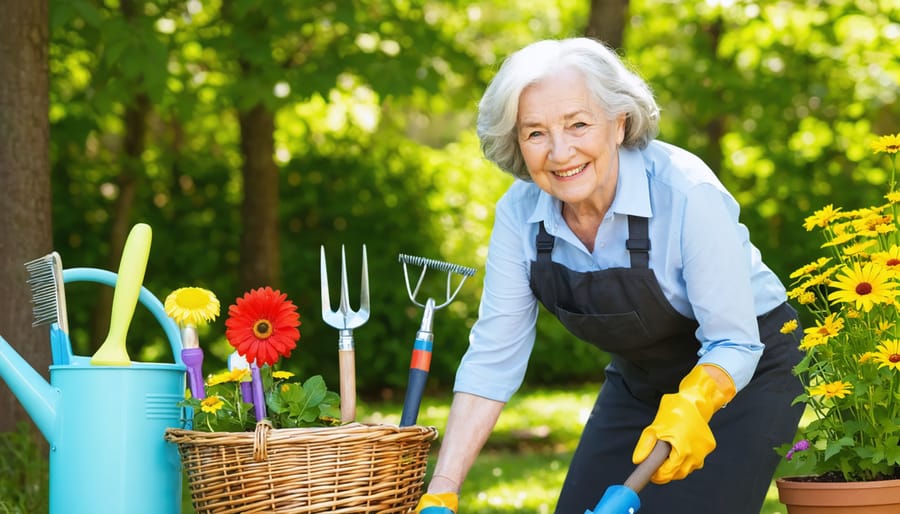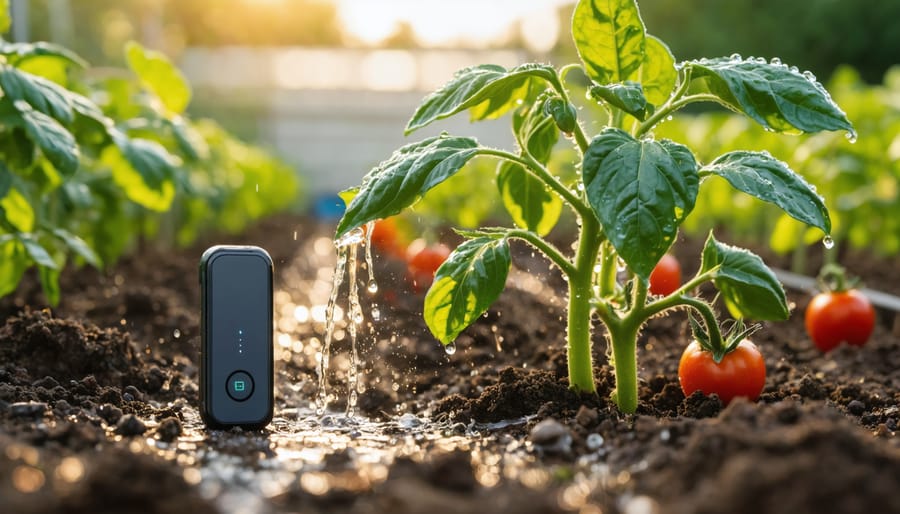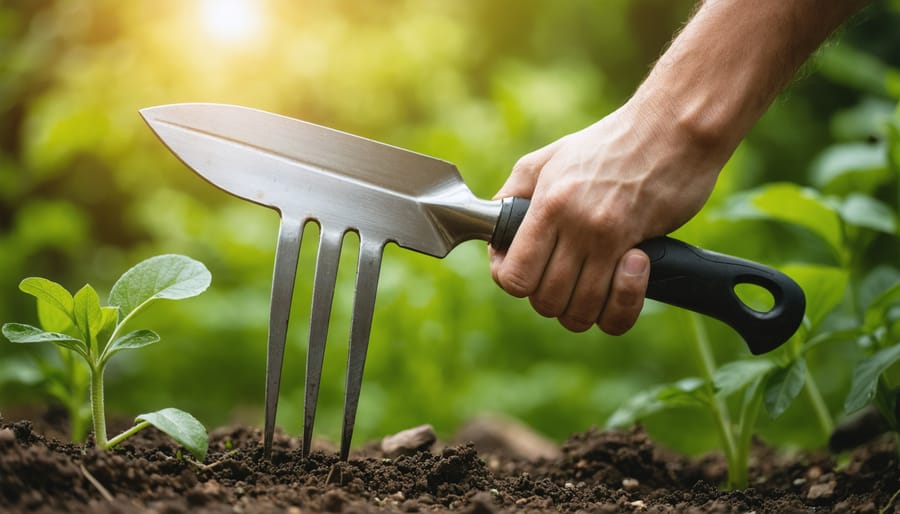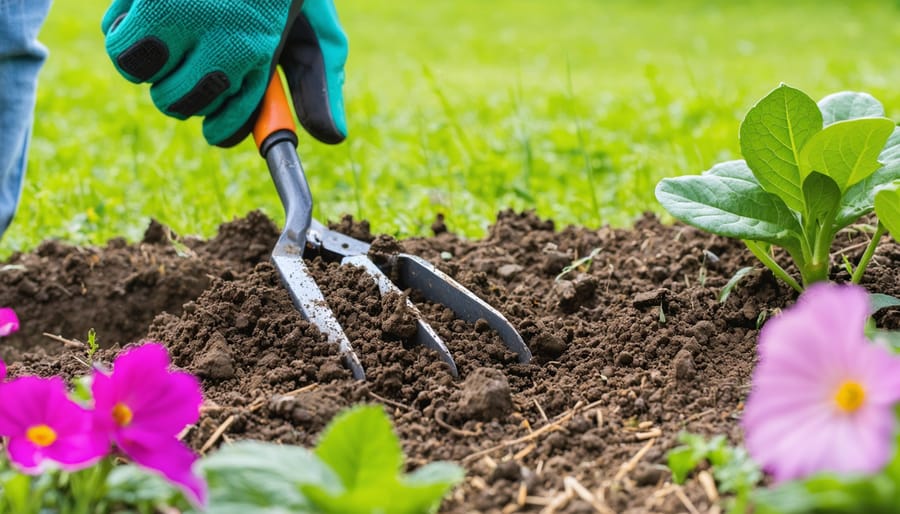Transform your gardening experience with ergonomically designed gardening tools for seniors that reduce joint stress and prevent fatigue. Long-handled tools with cushioned grips eliminate excessive bending, while lightweight materials like aluminum and carbon fiber make every gardening task manageable. Smart design features such as rotating handles, pistol grips, and extendable reaches have revolutionized traditional gardening implements, allowing seasoned gardeners to maintain their beloved hobby with confidence and comfort. These thoughtfully engineered tools don’t just make gardening possible—they make it enjoyable again, combining innovative ergonomic principles with time-tested functionality to create equipment that works as naturally as an extension of your own body. Whether tending to raised beds or maintaining ground-level gardens, the right ergonomic tools can help preserve both your garden and your health for years to come.
Why Ergonomic Tools Matter for Senior Gardeners
Common Gardening Challenges for Seniors
Gardening can present unique challenges for seniors, but understanding these common issues is the first step toward finding effective solutions. Arthritis, a frequent concern among older gardeners, can make gripping and manipulating traditional tools painful and difficult. Many seniors also experience reduced hand strength, making tasks like pruning or digging particularly challenging. Balance issues may create safety concerns, especially when bending, kneeling, or working on uneven ground.
Vision changes can affect depth perception and make it harder to spot potential hazards or distinguish between plants and weeds. Limited mobility and reduced stamina might restrict the time spent gardening or make certain areas of the garden less accessible. Back pain and joint stiffness can turn previously enjoyable tasks into uncomfortable experiences.
Despite these challenges, there’s no need to give up gardening. With the right tools and adaptations, seniors can continue to enjoy their favorite hobby safely and comfortably. Understanding these limitations helps in selecting appropriate ergonomic tools that address specific needs while maintaining independence in the garden.
Benefits of Ergonomic Tool Design
Well-designed ergonomic gardening tools offer several key benefits that make gardening more enjoyable and sustainable for seniors. The carefully engineered handles reduce wrist and hand strain by keeping your joints in a natural position while you work. Cushioned grips provide better control and comfort, preventing blisters and reducing hand fatigue during extended gardening sessions.
Ergonomic tools often feature longer handles and angled heads, which minimize the need to bend or stretch. This design helps prevent back pain and reduces stress on shoulders and knees. The lightweight materials used in these tools make them easier to maneuver, allowing seniors to garden for longer periods without becoming overtired.
Many ergonomic tools also incorporate features like bright colors for better visibility and non-slip surfaces for added safety, especially in wet conditions. These thoughtful design elements not only make gardening more comfortable but also help maintain independence and confidence in the garden.


Essential Ergonomic Tools for Senior Gardeners
Long-Handled Tools with Comfortable Grips
Long-handled gardening tools are a game-changer for seniors who want to maintain their love for gardening while protecting their backs and joints. These thoughtfully designed tools eliminate the need for excessive bending and stooping, allowing gardeners to work from a comfortable standing position.
Look for tools with handles that extend between 36 to 48 inches, providing excellent reach without compromising control. The best options feature ergonomic D-shaped or T-shaped grips made from soft, non-slip materials like rubber or foam. These specially designed handles reduce hand fatigue and maintain a secure grip even when working with damp soil.
Popular long-handled tools include cultivators for loosening soil, trowels for planting and transplanting, and pruners for reaching high branches. Many modern versions come with lightweight aluminum or carbon fiber handles that offer strength without adding unnecessary weight. Some even feature adjustable handle lengths to accommodate different tasks and user heights.
To maximize comfort and efficiency, choose tools with brightly colored handles for better visibility and angle-adjustable heads that help maintain proper posture while working. Extra features like handle loops for easy storage and textured grips for wet conditions make gardening tasks even more manageable.
Remember to look for tools with warranty coverage, as quality long-handled tools are an investment in your gardening comfort and longevity. Many gardeners find that having a complete set of these tools helps them maintain their garden independence while protecting their body from strain.
Light-Weight Tools for Reduced Strain
When it comes to enjoying gardening comfortably, the weight of your tools makes all the difference. Modern lightweight materials like aluminum, carbon fiber, and reinforced plastics have revolutionized gardening tools, making them easier to handle without sacrificing durability. These materials significantly reduce arm and shoulder strain during extended gardening sessions.
Look for tools with hollow handles, which maintain strength while cutting down on weight. Many manufacturers now offer ultra-light trowels weighing less than 8 ounces and pruners under 6 ounces. Telescopic handles are another excellent feature, allowing you to adjust the tool’s length and leverage without adding unnecessary bulk.
For everyday gardening tasks, consider investing in a lightweight tool set that includes essential items like a trowel, cultivator, and weeder made from aircraft-grade aluminum. These typically weigh 40-50% less than their traditional counterparts. Ergonomic pruners with composite handles offer excellent cutting power while being remarkably light, perfect for extended pruning sessions.
Remember that lighter doesn’t always mean less effective. Many lightweight tools incorporate smart design features like textured grips and balanced weight distribution to enhance performance. When selecting tools, try them out if possible – what feels light and comfortable for one person might not work for another. The key is finding tools that allow you to garden longer without fatigue while still getting the job done effectively.
Specialized Adaptive Tools
For gardeners with specific physical limitations, adaptive gardening tools can make all the difference in maintaining their beloved hobby. These specialized tools are thoughtfully designed to address various mobility and strength challenges while ensuring comfort and safety.
For those with limited grip strength, there are tools featuring easy-grip handles with soft, cushioned materials and extra-wide grips. Ratcheting pruners and loppers multiply your natural hand strength, making cutting tasks significantly easier. Some models even include power-assist features that reduce the force needed by up to 70%.
Arthritis-friendly tools come with rotating handles that move with your natural wrist motion, preventing strain and discomfort. Long-reach tools with telescoping handles help reduce bending and stretching, perfect for those with back issues or limited mobility. These extensions can add anywhere from 2 to 5 feet of reach while maintaining precise control.
For wheelchair users, there are specially designed rolling gardens seats that can double as tool carriers, and raised bed tools with angled handles for better access. Many of these tools feature bright, contrasting colors to make them easier to spot in the garden and prevent misplacement.
Remember, the key is finding tools that work with your specific needs rather than forcing yourself to adapt to standard tools. Consider trying different options to find what works best for your situation.
Maintaining Your Ergonomic Tools
Cleaning and Storage Tips
Proper care of your ergonomic gardening tools not only extends their lifespan but also ensures they remain safe and effective to use. After each gardening session, gently brush off excess soil and rinse your tools with water. For stubborn dirt, use a wire brush or putty knife to clean the metal parts thoroughly. Once clean, dry your tools completely with an old towel to prevent rust.
Before storage, apply a light coat of mineral oil or WD-40 to metal surfaces to prevent corrosion. For wooden handles, consider using linseed oil every few months to prevent splitting and maintain grip comfort. Store your tools in a dry, covered area, either hanging on a pegboard or in a dedicated tool rack to keep them organized and easily accessible.
Consider keeping a bucket filled with sand mixed with a small amount of oil near your storage area. Dipping tool heads into this mixture after cleaning helps prevent rust and keeps them sharp. For tools with moving parts, like pruners or loppers, occasional lubrication of the joints will keep them working smoothly and reduce strain on your hands.
Remember to inspect your tools regularly for any signs of wear, loose handles, or damage that might compromise their ergonomic benefits or safety.

Regular Maintenance Checklist
To maintain your gardening tools in top condition, establish a simple routine after each gardening session. Clean tools thoroughly with a stiff brush to remove soil and debris, paying special attention to joints and grip areas. For ergonomic tools with cushioned handles, check regularly for wear and tear, and ensure grips remain secure.
Store tools in a dry place to prevent rust, and consider hanging them vertically to maintain their shape and prevent strain on handles. Every few months, inspect moving parts and lubricate them with appropriate oil to keep them working smoothly. This is especially important for tools with ergonomic features like adjustable handles or rotating heads.
Keep blades sharp – dull tools require more force to use, which can strain muscles and joints. Wooden handles should be treated with linseed oil annually to prevent splitting and maintain their comfortable grip. Replace worn cushioning or grips promptly to ensure tools remain comfortable and safe to use.
Remember to check for loose screws or fasteners monthly, as these can affect the tool’s ergonomic benefits and overall safety. When stored properly and maintained regularly, quality ergonomic tools can provide years of comfortable gardening enjoyment.
Gardening is a lifelong passion that shouldn’t be limited by age or physical constraints. By choosing the right ergonomic tools and maintaining them properly, seniors can continue to enjoy their beloved hobby while protecting their health and safety. The carefully designed features of ergonomic gardening tools – from enlarged grips to extended handles and lightweight materials – make all the difference in reducing strain and preventing injury.
Remember that investing in quality ergonomic tools is an investment in your gardening future. While these tools may cost more initially, their durability and ability to prevent gardening-related injuries make them worth every penny. Regular maintenance of your tools, including cleaning after use, proper storage, and occasional sharpening, will extend their lifespan and ensure they continue to serve you well.
Listen to your body and adjust your tool collection as needed. What works perfectly today might need to be replaced with something more suitable as your needs change. Don’t hesitate to try different tools and modifications until you find the perfect fit for your gardening style and physical capabilities.
With the right ergonomic tools in your shed and proper care routines in place, you can look forward to many more years of creating and maintaining your beautiful garden. After all, gardening isn’t just about growing plants – it’s about nurturing your well-being and maintaining an active, fulfilling lifestyle throughout your golden years.




